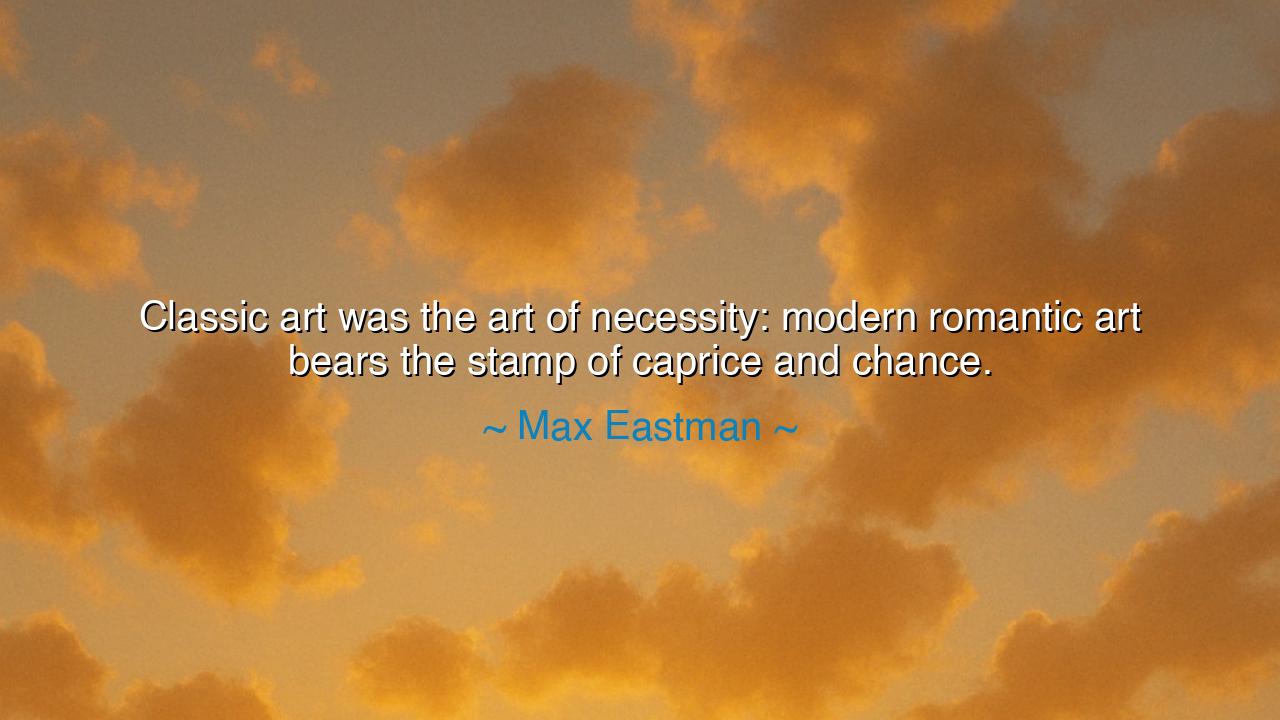
Classic art was the art of necessity: modern romantic art bears
Classic art was the art of necessity: modern romantic art bears the stamp of caprice and chance.






In the vast river of time, the flow of art has often been shaped by the currents of necessity and desire. As Max Eastman so eloquently stated, "Classic art was the art of necessity: modern romantic art bears the stamp of caprice and chance." This truth speaks to the evolution of human expression through the ages, reflecting how the driving forces behind artistic creation have shifted from the urgent demands of survival to the whims of personal choice and emotion. In ancient times, art was often created out of a need—to preserve history, convey stories of gods and heroes, and serve practical or ceremonial purposes. But as societies grew more complex, art became less about necessity and more about the exploration of the self and the unpredictable.
In the ancient world, the works of Greek sculptors such as Phidias and Polykleitos were born of necessity—born from the desire to honor the gods, to preserve the ideals of the city-state, and to show the perfection of the human form. These sculptors did not merely create out of whim or fancy, but out of a profound need to capture the divine and the ideal, to ensure that future generations would see the truth in their portrayal of gods and heroes. Their work was driven by the order of their culture, the expectation that art would elevate the spirit and reflect the strength of the human body and mind. The classical art they created was not random but necessary, a product of societal ideals that transcended individual will.
The Romans, too, created art with purpose. Their statues, mosaics, and frescoes were often commissions from rulers and emperors, designed to glorify their reigns, commemorate their victories, and elevate the political stature of the empire. Even in the vast arenas of the Colosseum, where gladiators fought and emperors watched, the art of arena design and architecture was created to serve a functional and symbolic role—showing power, control, and the grandeur of the empire. Every aspect of Roman art was a response to the needs of the state, a necessary extension of the empire's political and military might.
However, as time flowed forward and the Renaissance gave way to the Baroque period, the world saw a shift in the very heart of creation. Romanticism emerged in the late 18th century, and with it, a new spirit of freedom, emotion, and individuality. Art was no longer simply about what was necessary for the state or the divine. It became about personal expression, the artist’s inner world laid bare for the public to view. Turner, Delacroix, and Géricault painted not only to preserve moments of importance, but to express the depth of human feeling—the chaos of a storm at sea, the passion of a revolutionary moment, the wildness of a mad horse. The work of these Romantic artists was emotional and intuitive, a product of caprice—of whims and desires that could not be neatly explained by the logical, structured world of classical antiquity.
The concept of chance is inseparable from the Romantic era. As the Impressionists later followed in the footsteps of their Romantic predecessors, they painted not just for beauty or preservation but for the fleeting moments of life—the light shifting across the landscape, the motion of the crowd, the effects of time on a moment captured in a frame. These artists sought to reflect reality as it was in that brief, unstable instant, not as something eternal and fixed. Their art, like the Romantic, was born of the artist's inner yearning and spontaneous perception, a result of the whims of the mind and the moment.
In our own time, the shift from necessity to caprice is even more pronounced. The artist of today often finds themselves not bound by the constraints of societal needs, but free to explore their own inner desires, experiment with form, and challenge the very definition of art. Pop art, abstract expressionism, and even street art are all born from the idea that art is not merely a reflection of necessity but a personal expression of the world as seen through the eyes of the artist. It is free-flowing, often playful, sometimes chaotic, and always seeking to break the rules that once governed the creation of art.
The lesson from Eastman’s observation is profound and universal: art is both a reflection of necessity and a reflection of personal freedom. In the ancient world, art was a tool of survival, of glorification, of preservation. Today, it can be an act of caprice, driven by the desire for personal exploration and expression. Both forms are valid, and both serve their own purposes. As we walk our own paths, we must remember that creation itself is driven by forces both internal and external—by necessity and by whim. We must embrace both sides, creating not only out of necessity, but also in pursuit of our deepest desires, understanding that it is the tension between these forces that propels art and life forward. Let us create with freedom in our hearts and the wisdom of the past to guide us.






AAdministratorAdministrator
Welcome, honored guests. Please leave a comment, we will respond soon